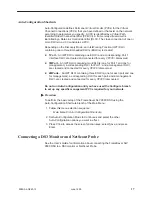
17
9580-A2-GZ40-10
June 1999
Auto-Configuration Shortcuts
Auto-Configuration defines Permanent Virtual Circuits (PVCs) for the Virtual
Channel Connections (VCCs) that you have defined or that exist on the network,
according to parameters you specify. A VCC is identified by a Virtual Path
Identifier/Virtual Channel Identifier (VPI/VCI). A frame relay virtual circuit is
identified by a Data Link Control Identifier (DLCI). The cross-connection of one or
more DLCIs to a VCC constitutes a PVC.
Depending on the Discovery Mode, an InterWorking Function (IWF) DLCI
containing one to three Embedded DLCIs (EDLCIs) is created:
H
1Port – An IWF DLCI containing one EDLCI and a corresponding Port 1
interface DLCI are created and connected for every VPI/VCI discovered.
H
1MPort – An IWF DLCI containing two EDLCIs (one for Port 1 and one for
management), a corresponding DLCI for Port 1, and a management DLCI,
are created and connected for every VPI/VCI discovered.
H
2MPorts – An IWF DLCI containing three EDLCIs (one for each port and one
for management), a corresponding DLCI for each port, and a management
DLCI, are created and connected for every VPI/VCI discovered
.
Do not run Auto-Configuration until you have used the Configure branch
to set up any specific management PVCs required for your network.
"
Procedure
To perform the basic setup of the FrameSaver SLV 9580 DSU using the
Auto-Configuration Shortcuts branch of the Main Menu:
1. Follow this menu selection sequence:
Main Menu
→
Auto Configuration Shortcuts
2. Set Auto-Configuration Mode to Continuous and select the other
Auto-Configuration options you want in effect.
3. Press Ctrl-a to access the screen function keys, select Save, and press
Enter.
Connecting a DS3 Monitor and NetScout Probe
See the User’s Guide for information about connecting the FrameSaver SLV
9580 DSU to a DS3 monitor or NetScout Probe.
















